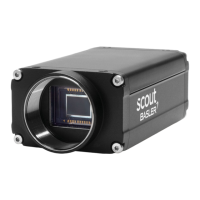AW00011916000 Standard Features
Basler scout GigE 245
Using the Load Command
There is also the Sequence Set Load command that may be useful when working with the sequence
sets for testing purposes. If you use the Sequence Set Index parameter to select a sequence set
and then you execute the Sequence Set Load command, the sequence parameter values in the
active set will be replaced by the values stored in the selected sequence set.
This ability can be useful in two situations. First, if you simply want to see how the parameters
currently stored in one of the sequence sets will affect camera operation, you can load the
parameters from that sequence set into the active parameter set and see what happens. Second,
if you want to prepare a new sequence set and you know that an existing set is already close to
what you will need, you can load the existing sequence set into the active set, make some small
changes to the active set, and then save the active set as a new sequence set.
Make sure the sequencer feature is disabled before issuing the Sequence Set Load command.
Synchronous advance and restart are part of the standard operation of the
sequencer feature and should generally be used. Asynchronous advance and
restart are not suitable for standard operation because of the associated delays:
The delay between sending a software command and it becoming effective will
depend on the specific installation and the current load on the network.
Accordingly, the number of image acquisitions that may occur between sending
the software command and it becoming effective can not be predicted.
Asynchronous advance and restart are therefore not suitable for real-time
applications, they may, however, be useful for testing purposes.
We strongly recommend to only use synchronous advance and synchronous
restart for real-time applications.
You can use the Sequence Set Index chunk feature to add a chunk to each
acquired frame. The chunk contains the index number of the sequence set that
was used for the frame acquisition. For more information about the Sequence set
Index chunk, see the "Chunk Features" section.
Replacing the sequence parameter values in the active set via the Sequence Set
Load command is associated with a delay between sending the software
command and it becoming effective. The delay will depend on the specific
installation and the current load on the network. Accordingly, the number of image
acquisitions that may occur between sending the command and it becoming
effective can not be predicted. The Sequence Set Load command is therefore not
suitable for real-time applications, it may, however, be useful for testing purposes.

